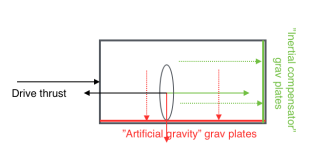Manuver drives, if the iterations of CT's ship construction Inertial Compensation is part and parcel of that installation.
As part of the driscription in Book5 thrust is limited by compensation.
In a lot of ways it makes more sense to have Inertial Compensation as part of the hull calculations. In that you can have oversized drives, but use beyound the hull's compensation limit requires the crew to strap in. Also over-stressing the the hull can lead to adventure causing complications as well.
Book5 change for this is Manuver number precentage turns into 2% per drive number for thrust. While Compensation as part of the hull is total thrust (Gs) compensated minus one equels the persentage required as part of the hull.
i.e.
Net result is no change in total volume required in the Book5 system. Book2 requires a little more work though.
Comments?
Side note MT half assedly does the above, while it part of TNE.
As part of the driscription in Book5 thrust is limited by compensation.
In a lot of ways it makes more sense to have Inertial Compensation as part of the hull calculations. In that you can have oversized drives, but use beyound the hull's compensation limit requires the crew to strap in. Also over-stressing the the hull can lead to adventure causing complications as well.
Book5 change for this is Manuver number precentage turns into 2% per drive number for thrust. While Compensation as part of the hull is total thrust (Gs) compensated minus one equels the persentage required as part of the hull.
i.e.
- m1 = 0%
- m2 = 1%
- m3 = 2%
- Etc... ect.
Net result is no change in total volume required in the Book5 system. Book2 requires a little more work though.
Comments?
Side note MT half assedly does the above, while it part of TNE.

